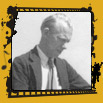 Heritage Community Foundation Presents
Heritage Community Foundation PresentsAlberta Online Encyclopedia
 |
 |
 |
||||||||||||
     |
Artists Biography - Henry Glyde In September 1935, Henry George Glyde, his wife Hilda and their daughter Helen arrived in Calgary. Invited by painter A.C. Leighton, to join the faculty at the Provincial Institute of Technology, Glyde and his family had arranged a one year leave of absence from his position in England, at the High Wycombe School of Art. Their intention was to stay only a year. After what turned out to be 30 years of teaching, and more than 60 years of painting in Alberta, many came to view Glyde as one of the most important individuals in the development of art teaching in the province. Within a year of his arrival in Calgary, he was head of the art department, at the Provincial Institute of Technology, the precursor of the Alberta College of Art and Design. He was also head of a division of the Banff School of Fine Arts from 1936 until 1966.
The subjects of Glyde's most interesting and significant works are the oils and murals that document urban and rural prairie life, a style known as social realism. Painting during a time of dynamic change in Alberta (including the shift toward urbanization in the wake of the Second World War and the discovery of oil in 1948) Glyde's work reflects the province's transitions. His murals, such as Alberta History, situated in Rutherford Hall at the University of Alberta, feature sombre colours and mythological figures, symbolic in mood and content, reflecting his ability in classical techniques. Grain elevators were common figures in works such as The Exodus and Aftermath. Glyde called them "cathedrals of the prairies", likening them to the church spires of England that marked towns and villages from a distance. Glyde admired the simple and functional architecture of these structures, giving a point of defintion to Alberta's small towns and hamlets. Born in Luton, England in 1906, Glyde decided early, and contrary to his family's wishes, to study art. While he developed his style in accordance with artistic concepts of 1920s England, it soon became apparent Glyde was committed to birthing a truly Albertan style, based on the people and landscape of the region he was immersed in.
In 1982, he was awarded an honourary degree from the University of Alberta in recognizing his dedication and contribution to the visual arts in Alberta. A major retrospective exhibition was produced by the Glenbow Museum in 1987. Henry George Glyde died in Victoria on March 31st, 1998. |
|
||||||||||||
|
|
||||||||||||||
|
Copyright © 2003 Heritage Community Foundation All Rights Reserved |
||||||||||||||
 |
 |
 |
||||||||||||
For more on Alberta's Arts Heritage, visit Peel’s Prairie Provinces.





